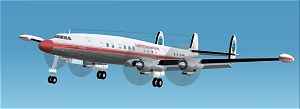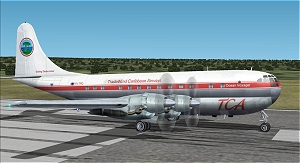|
FS2002 Lockheed Super Constellation PJ-SUS 'Susannah'
in 60s TradeWind Caribbean Airlines livery
History: Super Constellation
Introduction Designed and built by the Lockheed Aircraft
Corporation to the specification of the legendary Howard Hughes, the Constellation,
the world's first commercially successful pressurized airliner, heralded
a new post-war era of safe, comfortable and fast transatlantic air travel.
This graceful looking aircraft with its long sinuous fuselage - curving
downward at the nose and upward at the rear to its distinctive tripletail,
became synonymous with the halcyon days of the big Propliners and is still
widely regarded with awe and affection.
In all, 856 Constellations were built, ranging from the
first C-69 variant to the magnificent L-1649 Starliner. Sadly 55 years
after the first aircraft flew, only a handful remains airworthy as a vibrant
reminder of perhaps the most beautiful propliner of them all.
Aircraft design - Born out of a requirement for a long range commercial
transport, capable of non-stop travel between New York and Los Angeles,
the Constellation was a product of Lockheed's design office staff lead
by their chief designer, Clarence L. Kelly Johnson. The same team had
already been responsible for the successful series of commercial aircraft
including the twin engined Electra and Lodestar and was now working on
the design of a new airliner for Pan American (PAA). Known as the model
44 Excalibur, it offered a similar layout to their previous products but
with the capacity to accommodate up to 40 passengers. During project discussions,
the customer called for a larger aircraft with a pressurized fuselage
and, while thought was being given as to how this could be achieved, a
significant development occurred. In June 1939, Howard Hughes, a majority
shareholder in Transcontinental & Western Airlines (TWA), joined the
project with a requirement for a completely new commercial transport capable
of sustaining 250 mph at 20'000 ft, with a 6'000 lbs payload over a range
of 3'500 miles. The definitive design of this new aircraft was produced
by the end of the same year and although it bore the model 49, there were
considerable similarities between it and the model 44. The cost of a production
aircraft in 1939 was expected to be US$ 425'000.--
To produce an aircraft which would meet the exacting specification
set by Howard Hughes, a number of major issues had to be addressed and
in particular, the choice of engines and propellers. Eventually, it was
decided to equip the aircraft with new and extremely powerful, Wright
18 cylinder R-3350 engines. Each engine produced over 2'200 hp and turned
a huge, 15'2 " diameter propeller. However, this combination gave
rise to a few specific design challenges. Ground clearance on the massive
propellers necessitated an unusually long undercarriage although careful
design of the forward fuselage shape helped to reduce this. Again the
size of the propellers dictated the wide spacing of the engines along
the wing. This, in turn, created a need for considerable tail area to
ensure that directional-control was maintained during any asymmetric configuration.
Thus, the large tailplane with its distinctive triple fin arrangement
was raised out of the engines' slipstream and mounted high on the rear
fuselage. It was for these reasons that the unique cambered shape of the
fuselage evolved, resulting in the now legendary "Connie" shape.
The beautiful elliptical wing shape was a direct adaptation of the Lockheed's
P-38 Lightning wing section, which offered the best compromise between
lift and drag with excellent stall characteristics. The wing conferred
such high performance on the Constellation that, when first built, it
was faster than any contemporary for engined bomber and could actually
exceed the speed of some versions of the Mitsubishi A6M Zero fighter.
Airline orders - The confidence of both PAA and TWA in the L-049 design
was such that even before construction had begun the latter carrier had
placed an order for nine aircraft, which it later increased to 40, whilst
PAA followed suit soon after with an initial order for 40. However, history
conspired to deny Lockheed their commercial triumph when, following America's
entry into World War II, all civil contracts were frozen and the production
lines were taken over by the U.S. Army.
World War II - The L-049 was redesignated the C-69 by the United States
Army Air Force (USAAF) and orders were placed for a total of 180 of the
aircraft with the prototype first flying on the January 9, 1943. By early
1945, the C-69 had been incorporated into the USAAF's Air Transport Command
Service and was being flown, on behalf of the USAAF, by crews from both
PAA and TWA on routes between the United States and Europe. However, as
hostilities drew to a close, only fifteen C-69's had been delivered and
the military order was subsequently reduced to 73 aircraft.
Consequently, Lockheed were left with surplus airframes
and the Company decided to steal a march on their competitors by introducing
a modification program to convert the C-69s for civilian use whilst developing
a true civilian variant for airline customers. This prudent move gave
Lockheed a significant lead over their rivals, the Douglas DC-6 and the
Boeing Stratocruiser (both of which were almost 18 months behind their
development) and resulted in orders for over 100 L-049s, from eight airlines,
within a week of V-Day.
Further Connie development - The L-049 was little more than an interim
version in the development process and the first true commercial variant
of the Constellation was the L-649. This model incorporated the first
of many performance and system updates that were to be a feature of the
Constellation's development. Eastern Airlines was the only customer for
the L-649. The subsequent L-749 variant represented the culmination of
the original design. Enhanced capability, through increased power, extended
range and higher operating weights, made the L-749 a far more attractive
proposition for the airlines.
The L-1049 Super Constellation, which first flew in July
1951, offered major improvements in range and payload and these aspects
continued to be refined as the series was developed. Progressive engine
developments resulted in the turbo-compound version, which produced 3250
hp through the addition of power recovery turbines (PRT). This modification
drew energy from spent exhaust gases and fed the recovered power back
into the rear of the engine crankshaft, through a geared coupling, to
provide a 20 % increase power. The most noticeable visual changes came
from its increased length of 18 ft 4 in, through the insertion of two
fuselage plugs, one forward of wing and one aft and the replacement of
main cabin portholes with squared windows. The flight deck environment
was also improved to aid crew comfort and included redesigned flight deck
glazing. Most national flag carriers including Air France, BOAC, IBERIA,
KLM and Lufthansa in Europe, Northwest and TWA in the United States and
Air India and Qantas in the Far East flew Super Constellations.
The ultimate Constellation was the L-1649 Starliner. Driven
by the requirements of TWA for an extra long range aircraft to counter
the competition from the Douglas DC-7C, the Starliner was created by a
marriage of the L-1049G fuselage to a totally new wing design, which offered
the aircraft transoceanic range and a significantly improved performance.
Representing the pinnacle of piston-engined air transport
design, the Starliner's operational career was curtailed by the dawning
of the jet age. In fact, the first jet services began very shortly after
the Starliner's debut on the North-Atlantic routes, and effectively made
the type redundant, which resulted in a production run of only 44 aircraft.
The Starliner, which cost Lockheed US $60 million to develop, was the
company's only unprofitable Constellation variant.
TradeWind operated the type in the mid 60s, during the transition from
'Airways' to 'Airlines'. As a consequence a variety of schemes were seen
across the then fleet.
|

|












